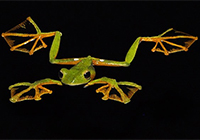Treasure of the month
November 2016
Wallace Flying Frog

The Wallace flying frog is the largest tree frog in Borneo. It lives high up in the treetops of the rainforest and only comes down from there to mate and lay eggs. In the canopy of the rainforest, it gets from tree to tree by swooping down and spreading its fingers and toes. The skins between them stretch and form wings that convert the free fall into a glide; it glides to the next tree.
While the scientific name refers to the black flying skins of the hands and feet, the colloquial name, Wallace Flying Frog, is a tribute to the naturalist Alfred Russel Wallace, who encountered this frog on his travels through the Malay Archipelago and whom he also illustrated. The species was described by Boulenger in 1895 and is also represented in the herpetology collection of LIB.
Prof. Dr. Alexander Haas, head of the Herpetology Department, has been conducting taxonomic, morphological, and phylogenetic research on the amphibians of the rainforests of Borneo (www.frogsofborneo.org) since 2001, in part at sites where Wallace had collected. Since Wallace, our knowledge of the frogs of Borneo has increased enormously. Many new species have been discovered, some also in the project of Prof. Dr. Haas. Nevertheless, the Wallace flying frog remains a charismatic species, iconic for the fascinating frog fauna of Borneo.

